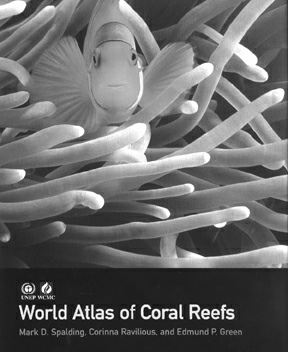World Atlas of Coral ReefsContents of this Issue: Travel Insurance in a Time of Terrorism Dive Travel in These Turbulent Times Dacor Recall and Phony Tank Testing The State of the World’s Reefs Editorial Office: Ben Davison Publisher and Editor Undercurrent 3020 Bridgeway, Suite 102 Sausalito, CA 94965 from the October, 2001 issue of Undercurrent
If there is one book that belongs in every traveling diver’s library, this is it. The superb World Atlas of Coral Reefs has everything you want to know about the reefs from Costa Rica and Cuba to the Coral Sea and Cayman. The information is specific and up to date. The photos, maps and layout are superb. And the price, for this 424-page, full color, hardbound volume, is a steal at $45. • 94 maps, including global maps of biodiversity and reef stresses, regional maps showing 3-D bathymetry and high resolution maps showing reefs, mangroves, population centers, dive centers and protected areas. • 280 color photographs, showing reefs, wildlife, people and places, including 84 photographs taken from space by Shuttle astronauts. • Text explaining the formation, structure and ecology of coral reefs; their various uses and abuses at the hands of humans; and the techniques used in coral reef mapping. • Detailed texts describing the distribution and status of coral reefs in every country. • Data tables listing information on biodiversity, human use, and protected areas. These include statistics on coral reef area, biodiversity, fish consumption, and threats. For example, you can learn about pollution damage to the reefs at Providenciales and the lack of human impact, as well. Or, where extensive bleaching took place in Honduras in 1998. You’ll read that Milne Bay in Papua New Guinea has the most extensive reef system in that country and where, in Fiji, the bumphead parrotfish and tridacna clams will not be found, thanks to overfishing. This is a remarkable book. Purchase it through the Undercurrent website Undercurrent, and our profit from the sale will go directly to the Coral Reef Alliance, a diver-based organization working hard to save the reefs. Click on books, then the photo of the World Atlas, and you’ll get it directly from Amazon.com, and CORAL will get a contribution. |

I want to get all the stories! Tell me how I can become an Undercurrent Online Member and get online access to all the articles of Undercurrent as well as thousands of first hand reports on dive operations world-wide
| Home | Online Members Area | My Account |
Login
|
Join
|
| Travel Index |
Dive Resort & Liveaboard Reviews
|
Featured Reports
|
Recent
Issues
|
Back Issues
|
|
Dive Gear
Index
|
Health/Safety Index
|
Environment & Misc.
Index
|
Seasonal Planner
|
Blogs
|
Free Articles
|
Book Picks
|
News
|
|
Special Offers
|
RSS
|
FAQ
|
About Us
|
Contact Us
|
Links
|
3020 Bridgeway, Ste 102, Sausalito, Ca 94965
All rights reserved.

 Clearly written with divers in mind, the
Atlas is an invaluable resource for global travelers. Here’s what
you’ll find:
Clearly written with divers in mind, the
Atlas is an invaluable resource for global travelers. Here’s what
you’ll find: